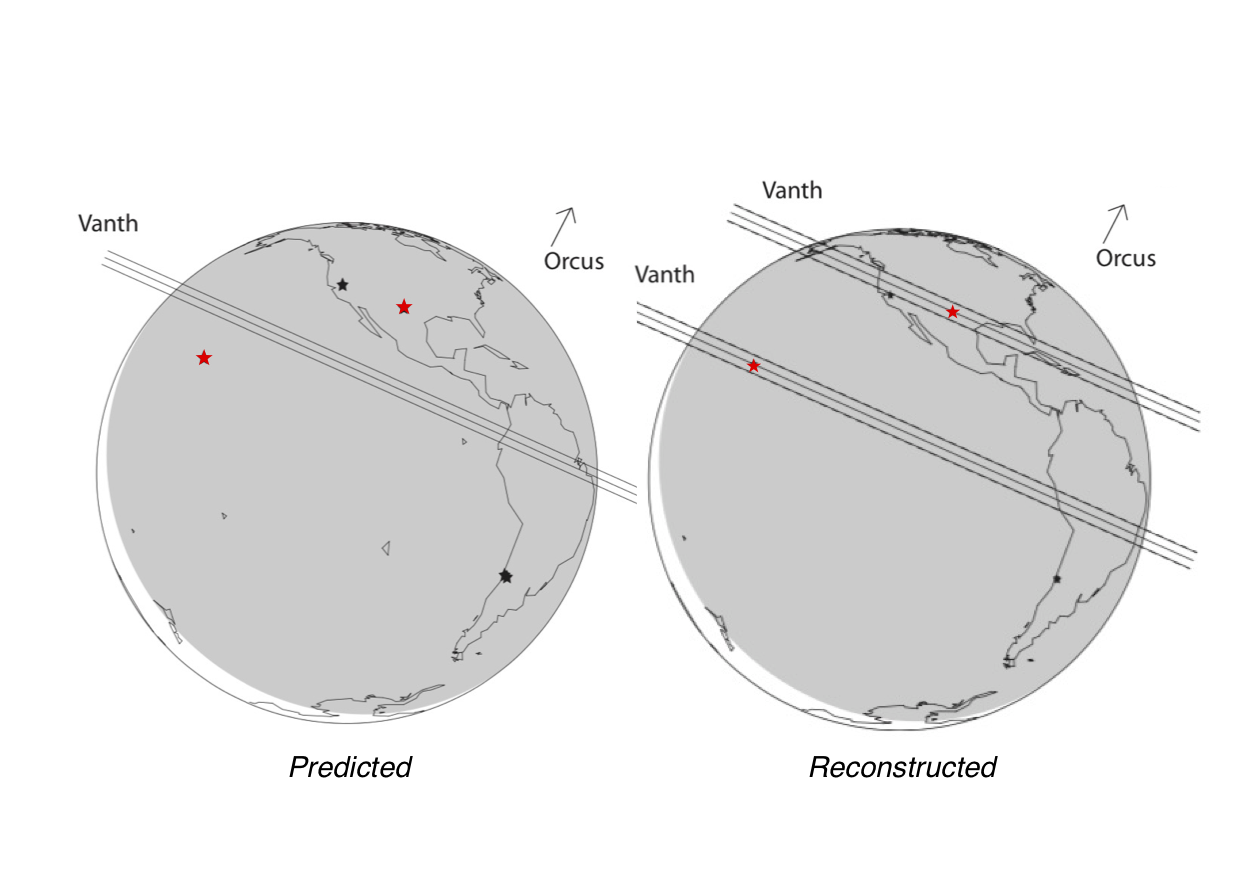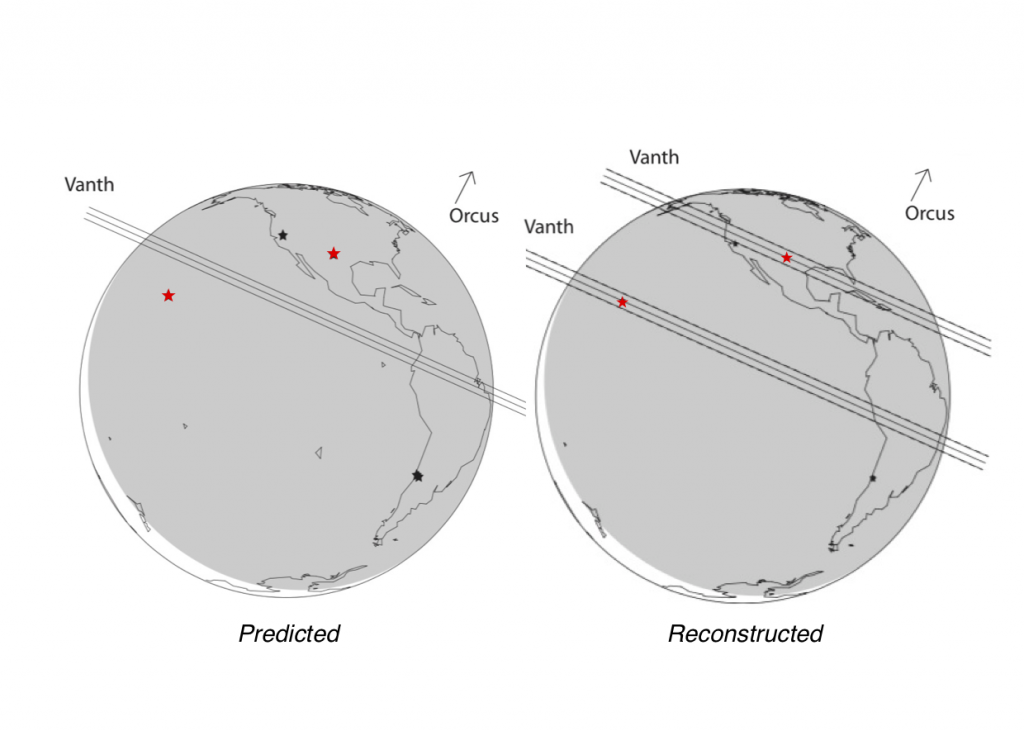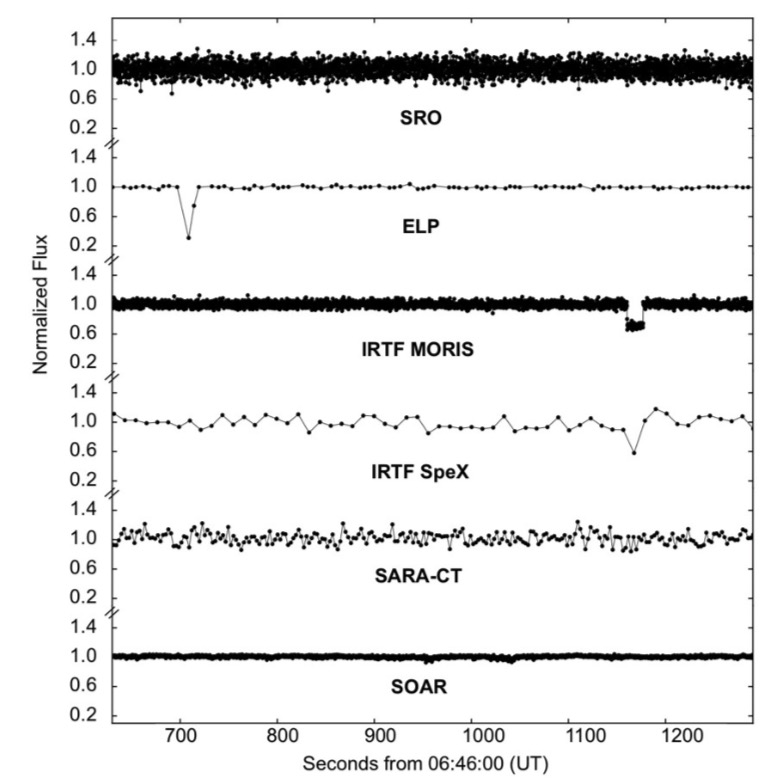
18 Dec A mystery in the outer Solar System
Stellar occultations are a powerful technique that allows characterization of foreground objects by watching them block light from a distant star. This technique is particularly useful for studying small and/or distant objects in the Solar System, which are difficult to see from the ground. In March 2017, a team of astronomers from the South African Astronomical Observatory and the Massachusetts Institute of Technology observed a stellar occultation that was predicted for the large, Trans-Neptunian Object (TNO) Orcus (Fig. 1, left).

Figure 1. (left) Predicted path of Vanth’s shadow for the 07 March 2017 occultation. (right) Reconstructed path, after obtaining confirmation of the visual double-star from Gemini. In each plot, the three lines represent the north, middle, and south extent of the shadow. The observing sites are marked by stars, with successful sites in red. Orcus’ shadow was well off the globe to the north and the error bars were approximately half the size of the Earth.
Prior to this observation, Orcus was known to be approximately 900 km in size and had one satellite, Vanth, with a size of roughly 280 km. The Orcus system is in a 3:2 orbital resonance with Neptune, similar to Pluto’s orbit. Although not expected to maintain an atmosphere, Orcus’ features could hint toward a possible resurfacing mechanism, such as cryovolcanism. Goals of the occultation observation included accurately constraining Orcus’ size, measuring any atmosphere around Orcus, and detecting rings or debris in the system.

Figure 2. Light curves from all observing sites (marked by stars in Fig. 1). SRO = 0.6-m at Sierra Remote Obs.; ELP = 1-m LCO at McDonald Obs.; IRTF MORIS & SpeX are two different instruments on the 3-m at Mauna Kea Obs.; SARA-CT =0.6-m at Southeastern Association for Research in Astronomy at Cerro Tololo Obs.; SOAR = 4.1-m Southern Astrophysical Research at Cerro Pachón Obs.
Five sites in North America attempted the observation, with locations spanning from Chile to northern California. Two sites successfully detected the star disappearing: NASA’s 3-m Infrared Telescope Facility (IRTF) on Mauna Kea, Hawai’i and a 1-m Las Cumbres Observatory (LCO) telescope at McDonald Observatory, Texas (Fig. 2). However, a quick analysis of the geometry and the timing showed that data did not align with the expectation of one star being occulted by one outer Solar System object. After months of careful study, the best guess was that one site observed an occultation by Vanth of the target star while the second site observed an occultation by Orcus of an unknown secondary star.

Figure 3. Subframe of the reconstructed image from Gemini DSSI, with the target star in the center. There is a natural quadrant ambiguity in the analysis of speckle data: two secondary stars are shown in the image, while only one is in the correct location. In this case, the correct secondary star is at a position angle of 316 deg (north through east) and is a mere 250 milliarcsec away from the primary.
An external reviewer recommended obtaining high-resolution images in order to definitively solve the mystery. So, a proposal was submitted to the 8.1-m Gemini South telescope to observe the star using the Differential Speckle Survey Instrument (DSSI). The DSSI speckle images easily detected a companion star 250 milliarcsec away from the brighter primary (Fig. 3). Armed with confirmation of the location of the second star, the occultation data were reanalyzed to reveal that both detections were of Vanth, each blocking one of the two separate stars (Fig. 1, right).
The data allowed Vanth’s size to be measured at 443±10 km in diameter. They also placed a constraint of a few microbars on any global Vanth atmosphere and did not detect any material in the two star paths down to a limit of a few km in extent.
Click here for the Gemini Observatory press release, “Outer Solar System Object has Astronomers Seeing Double”.
Publication details:
“A Stellar Occultation by Vanth, a satellite of (90482) Orcus”
Amanda A. Sickafoose, Amanda S. Bosh Stephen E. Levine, Carlos A. Zuluaga, Anja Genade, Karsten Schindler, Tim Lister, and Michael J. Person
Icarus, volume 319, pages 657-668
https://doi.org/10.1016/j.icarus.2018.10.016
Preprint available at https://arxiv.org/abs/1810.08977.
Contacts
Dr Amanda Sickafoose: amanda@saao.ac.za; Dr Daniel Cunnama: daniel@saao.ac.za 021 201 5169
